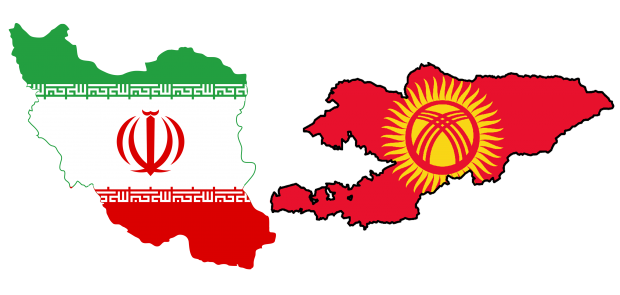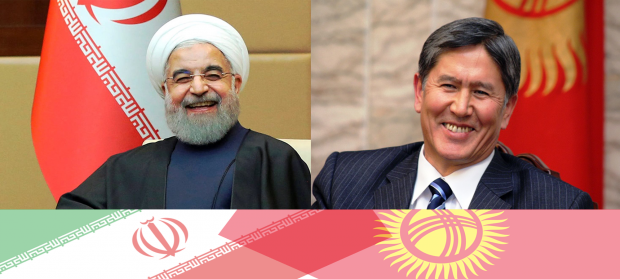
Significant Relations between Kyrgyzstan and Iran
Iran and Kyrgyzstan have embarked on what international experts are calling a “new era” of bilateral relations. September 2015 marked the beginning of a strong friendship between the two nations when President Almazbek Atambayev of Kyrgyzstan paid the Islamic Republic of Iran an official visit. Experts add that this visit was of great significance for both countries as Hassan Rouhani, President of the Islamic Republic, even invited the Kyrgyz President into his own palace—Sa’dabad Complex—in Tehran.
In his speech, Atambayev expressed gratitude to President Rouhani for his warm welcome and hospitality saying, “I am grateful for the invitation to pay an official visit to Iran—a country with 5000 years of history. Not every country can boast of such a rich historical background.” President of Kyrgyzstan continued to congratulate Iran for its adoption of the Comprehensive Action Plan to resolve issues surrounding the Iranian nuclear program. “This event would not have happened without the political will of the Iranian leadership. We are interested that all agreements reached would be successfully implemented and that there would be a speedy removal of international sanctions that are impeding efficient development of Iran,” Atambayev said.
Hassan Rouhani, in turn, greeted Atambayev: “Kyrgyzstan and Iran have common historical and cultural roots. We do not foresee any obstacles to deepening the cooperation between the two countries.” Rouhani further thanked the Kyrgyz Republic for their active cooperation and support along the framework of international organizations. During the official meeting, the two Presidents discussed many issues over a broad spectrum of topics, but mainly regarding bilateral relations, the implementation of joint infrastructure projects, and the prospects of trade and economic cooperation between Iran and Kyrgyzstan.
As the two Heads of State exchanged comments, they combined their political intentions in the form of official agreements. The following documents were signed by the two nations: The Protocol on Bilateral Consultations between the Ministry of Foreign Affairs of the two countries, the Transfer of Persons Sentenced to Prison Terms between Kyrgyzstan and Iran, Memorandum on Cooperation in Energy and Water Resources between the two nations, Memorandum relating to the Field of Agriculture and Land Reclamation, Memorandum of Cooperation between the Organization of Television of Iran and the Ministry of Culture, Information, and Tourism of Kyrgyzstan, Agreement of combined intention in the Branch of Aviation, agreement of Cooperation between the Chamber of Commerce of the Kyrgyz Republic and Iran’s Chamber of Commerce, Industry, Mines, and Agriculture.
 Also at this meeting, the President of Kyrgyzstan and Iran exchanged views on alarming regional developments in terrorism in Afghanistan, Syria, Iraq, and Yemen. The leaders stressed the need to strengthen cooperation on bilateral, regional, and international levels to aid in the fight terrorism in connection to religious extremism, organized crime, illicit drug and arms trafficking, and human trafficking. Both Heads of State instructed competent authorities within such fields in Kyrgyzstan and Iran to intensify cooperation efforts.
Also at this meeting, the President of Kyrgyzstan and Iran exchanged views on alarming regional developments in terrorism in Afghanistan, Syria, Iraq, and Yemen. The leaders stressed the need to strengthen cooperation on bilateral, regional, and international levels to aid in the fight terrorism in connection to religious extremism, organized crime, illicit drug and arms trafficking, and human trafficking. Both Heads of State instructed competent authorities within such fields in Kyrgyzstan and Iran to intensify cooperation efforts.
Atambayev and Rouhani also discussed the project of constructing a railway that would run through China, Kyrgyzstan, Tajikistan, Afghanistan, and Iran. Atambayev specifically invited Iran to implement projects on the construction of large hydropower stations along Kyrgyzstan.
The talks ended as Atambayev extended a mutual invitation to Rouhani on an official visit to Kyrgyzstan.
Within a year or so, President Hassan Rouhani arrived in Kyrgyzstan with the official delegation of the Islamic Republic of Iran. This visit marked the second trip made by the Head of Iran to Kyrgyzstan since 2013, which was a visit that worked to enhance participation in the 13th Summit of the Shanghai Cooperation Organization (SCO).
Throughout this second meeting, the Republic of Iran held talks with the Kyrgyz President, Atambayev, and Prime Minister, Sooronbai Jeenbekov. It became clear that the two countries were willing in the development of economic cooperation. After each talk, the Presidents signed a long-term program of cooperation between Iran and Kyrgyzstan that would run until 2026. This program determined the specific contours of practical cooperation that would take place in the following decade.
Another point worth noting is the attention that was paid to the issue of visas at the talks. While it seemed that neither country was willing to cancel the use of visas, but instead decided to open direct flights between the two countries and facilitating traveling for the purpose of business and leisure.
Rouhani also revealed Iran’s intention of building a partnership in the energy sector, which particularly striked the interests of Kyrgyzstan officials. The Kyrgyz President instructed the Iranian company, TANA Energy Management to develop an action plan for such partnership. TANA Energy Management then simply had to increase its contacts with the national energy holding company in Kyrgyzstan.
This time, with Rouhani’s visit to Kyrgyzstan, issues pertaining to the construction of a railway connecting China to the countries of the Persian Gulf was raised. Iran posed assertive questions regarding the sphere of transit that would fit the interests not only of Kyrgyzstan and Iran, but also all the countries within said region. Atambayev showed interest in constructing a railway that would cross China, Kyrgyzstan, Uzbekistan, Turkmenistan, and Iran.
Additionally, Atambayev conveyed Kyrgyzstan’s positive view towards Iran’s desire of obtaining full membership status in the SCO. Both countries were confident that Iran’s membership in the organization would strengthen the organization’s overal capacity in international cooperation.
Finally, the two Heads of State encouraged entrepreneurs in their respected nations to “make the most of current favorable conditions marked by the high level of bilateral political relations [between Kyrgyzstan and Iran].”



